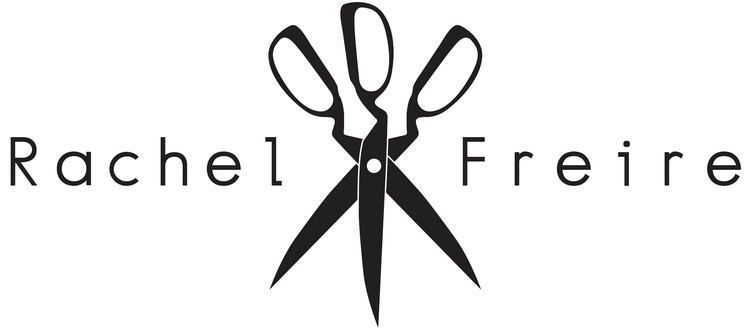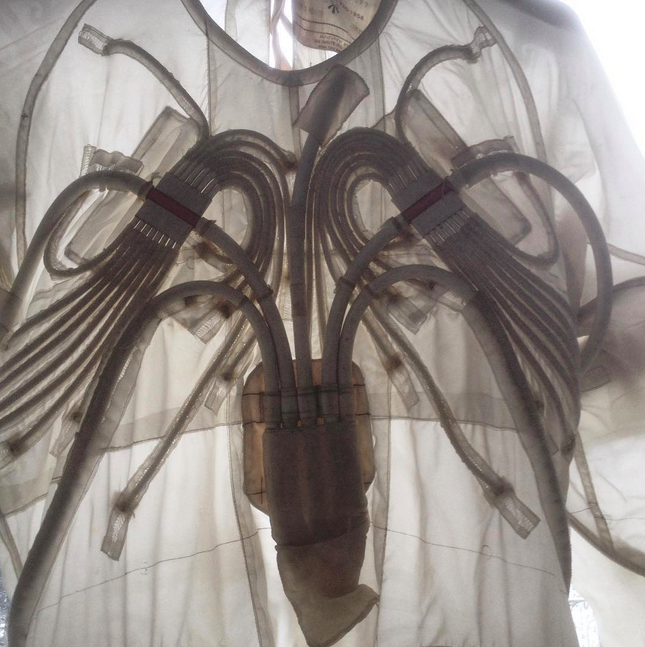FERROZUIT is a work-in-progress etextile collaboration by Cedric Honnet, Rachel Freire, London Cloth Co. and specialists from the Space Program at MIT.
STATUS: paused at the zero-G test flight stage during lockdown 2020 (yay Lacklustre Apocalypse!) and this page logs project links, experiments and thoughts until further dev occurs.
CONCEPT
A serious issue with human space exploration is the inevitable decay of muscle tissue and bone density due to the lack of gravity. We propose the design and testing of a prototype zero-gravity ferromagnetic suit that mimics Earth’s gravitational pull on the whole body. Our initial proof of concept is a ferromagnetic vest built from scratch (from custom woven ferromagnetic thread), and a electro-permanent magnetic base.
The material is conceived to be used for a space suit for the ISS; a soft, comfortable and passive magnetic fabric which can be activated by electromagnetic docking panels controlled by the wearer. This could allow astronauts to sit at a table or sleep without uncomfortable restraints, enabling them to gently locate themselves in zero gravity with minimal intrusive on-body mechanisms such as straps and harnesses. If woven magnetic coils were added, or individual panels on different areas of the body or the dock could be programmable, could a ferromagnetic suit even gently rock you to sleep?
PROCESS AND WORK-IN-PROGRESS LINKS:
https://www.media.mit.edu/projects/ferrozuit/overview/
https://zero-gravity.pubpub.org/pub/ferrozuit2020/release/1
Weaving the fabric with London Cloth Co.
Ferrozuit samples distributed in the 2020 etextile swatch exchange
Process photos of textiles, sampling and construction on Flickr
This project builds on the inspiration of Maximilian Guenther’s 2019 project ferrofluid space suit
WEAVING FERROMAGNETIC FABRIC FROM [LITERALLY] SCRATCH
To bring this project to life we had to start at the very beginning: cloth. Weaving is an ancient human tradition and one which has been refined over thousands of years. It could be said that humans evolved because of the very process of weaving, rather than the assumption it was borne from an evolution in human thinking.
We needed to take our custom designed ferromagnetic yarn and create a material to test whether our concept would work. To do this, it turns out, required both the knowledge of a crazy and curious specialist, but also a vintage loom. Old looms are more badass and adaptable to varied materials; modern computerised looms (the designs of which tend to be industrially specialised and limited to specific tasks) could not cope with the nature of the rough, metal thread.
Enter: inimitable genius Daniel Harris of the London Cloth Co. (nerds, machine porn appreciation types, go and check out his instagram. It’s wild. I recommend the chainsaw videos if excessive weaving is not your jam #noonepartieslikeaweaver)
It was not practical to create a fully metal fabric in both warp and weft. Result: "basically like wire wool but fluffier. Like a sheep had a baby with a foundry". The process created angry fluffy clouds of metal shavings and a slightly aggravated weaver: the sampling was uneven and impossible to mechanise on any usable scale. Although it may have been possible to tweak and refine this process using cunning and swearing, the material itself was too scratchy, crunchy. An overall displeasing textile:
The material is conceived to be used for a space suit for the ISS; a soft, comfortable and passive magnetic fabric which can be activated by an electromagnetic docking panel. This could allow astronauts to sit at a table or sleep without uncomfortable restraints, meaning it must also be able to sit against the body and not create discomfort.
The first successful test was woven on a 1950s antique loom using our loom-destroying iron-based yarn (as the warp) and a strong cotton (as the weft). The sample was successful and the cloth was strong in the textile sense, but weak as a magnetic object. The question then became: how to balance density of magnetic properties with strength of cloth.
The answer was to layer the material within the weave itself: Using the thick iron as the warp, combined with a much finer, super strong weft (dyneema?) to form a strong , balanced material. Then combine this with layers within the weave to multiply the density and therefore the magnetic properties of the material. We will use this first sample for our prototype vest, knowing the fabric handle can be maintained and refined using a thinner, stronger non-metal weft for future iterations.
first sample: iron warp and cotton weft creates a strong fabric with limited magnetic strength
developement: cotton weft was required for strength, so Daniel designed a multi-layered weave - crossing at 2cm intervals - to multiply the magnetic strength within the weave of the fabric itself
WEAVING TEST NOTES TAKE-HOME, BULLET POINT REVIEW:
iron warp/cotton weft – balancing the thickness of the active and non active threads: GOOD textile, BAD magnetic properties. Result:: FAIL
iron warp/iron weft – strong magnetic properties, awful textile texture. "basically like wire wool but fluffier. Like a sheep had a baby with a foundry". Scratchy/crunchy. Needs textile balance or will literally sheer itself/flake! Loom/weaver grumpy. Makes mess. Result: FAIL
layering within the weave - weaving two layers of fabric together and crossing/combining the weft at intervals: multiplies the magnetic properties. Result: PROGRESS!
next steps: testing fine super-strong threads/yarn in the weft to design a balanced fabric with softness and movement. HAS TO BE STRONG ENOUGH FOR THE MAGNETS! Continue with multi-layer weave.
layering is GOOD. IT adds PADDING. Can this also be utilised as pockets? Add magnetic coils, flat bendable magnetic panels (lazer cut mesh for stretch?) when we need to increase strength?
GARMENT TEST DESIGN V1:
Created for the MIT space program Zero G test flight
Ferrozuit samples distributed in the ETEXTILE SWATCH EXCHANGE 2020
Etextile swatch exchange is the branichild of Hannah Perner-Wilson and Mika Satomi of Kobakant. Each summer for many years, etextile experts from around the world would amassed in France at Les Moulins De Palliard to hang out, share techniques and develop projects together. The swatch exchange became our yearly tangible way to physically swap our work, creating unique and valuable documents of new, innovative techniques. The 2020 swatchbook was even more precious as it was made during lockdown, when we could not meet in person to share our discoveries. 20 samples are made by each participant, sent to be collated and bound into 20 books. The page format and documentation can be seen in the image below. All the previous swatchbooks can be seen on this website log
Swatchbook sample construction (mimicking the techniques of the prototype vest):
- uses very first successful fabric sampling prototype, warp/weft both ferromagnetic. Not stable enough for production on any scale (blocks the loom with shearings of iron fluff!). Multi-layered weave with ‘pockets’ woven into the weft: where the layers overlap, effectively two layers of fabric are woven into one piece of cloth. One side of the sample is left loose to show the layered nature of the weave.
- backed onto YULEX (sustainable neoprene substiture) laminated with velcro: a cushioned base to protect the wearer in a maleable impact-resistant material.
- ferro-fabric is broken zig-zag stitched on to the neo for strength and to allow stretch and movement
- Edging tape: Bemis Sewfree stretch bonding film is used to bond Carvico Vita (100% recycled polyamide) technical 4-way stretch knit fabric over the seams. Low profile super stretch seam tapes ( this is a custom recycled tape but wetsuit tape could also be used here)
PHILOSOPHICAL RAMBLINGS
ETEXTILES. Why? Why not just look at material innovations, bio fabrics, grown, felted engineered etc etc etc.
Well, weaving is OLD. There are many interesting discussions about the process itself and evolution. I find it interesting that now we have a RESOLUTION issue, especially in etextiles. It has almost made etextiles and woven materials a hold-over storytelling device while we wait for the next paradigm shift in material innovation which is actually scaleable.
but then you have linear manufacturing and we are not yet at a pont where specialist additive manufacturing can be provided for custom designs. Nor do people seem to know what exactly they would want if they could have it. Thats another wormhole for a different time
But weaving and wovens are interesting. I often have conversations with engineers (menfolk, I’m looking at you) about how archaic sewing is. well yeah, but sometimes you have to be willing to go backwards to move forwards. My answer is: stop complaining, I’m busy making a thing which you will inevitably try and derivatively monetise... why don’t you REDESIGN/IMPROVE/PROGRESS the sewing machine then, is your job no? They slope off to their child-like emergent 3D printer technology and hiss… So what is actually the issue? Modern machinery becomes refined in a linear manner, becoming more specialised for specific tasks. This led us to using a vintage loom to even be able to weave this innovative and experimental thread… the value we put into material exploration has a very commercialised (read: capitalisist) lean, so only the projects which fit a certain mould are able to be developed to viable, profitable scale. But ALL the original spacesuits were HANDMADE by WOMEN from an UNDERWEAR factory, because the men made hard suits which weren’t fit for purpose. And yes, it’s the etextile vanguard, knitting, weaving, hacking, that actually give these google bros their lead in to the ‘innovations’ they automate into uselessness. so, weaving. Going back to basics gives you freedom to completely control the textile on a material level as you invent it and prototype the design. It allows iteration which can then be assessed and sensible design decisions made. It’s as good a starting point as any… projects like this are a long game. It’s not really the flashy insta-hit viral video level generally required and supported by MIT, but if it was do-able that way, I’m sure it would have been done… </rant>
MISC INSPO/INFO:
Textiles: The art of Mankind, Mary Schoeser https://www.researchgate.net/publication/287880200_Textiles_The_Art_of_Mankind_Mary_Schoeser
Spacesuits: fashioning Apollo MIT press https://mitpress.mit.edu/9780262015202/spacesuit/
The evolution of an ancient technology. https://www.ncbi.nlm.nih.gov/pmc/articles/PMC5451833/ ‘Considered in the most general sense, technology consists of knowledge about how to modify our environment, passed from one generation to the next.’
https://research-portal.uea.ac.uk/en/projects/beyond-the-basket-construction-order-and-understanding Did this technology teach us to count? Heslop: “..it relies on the relationship of number, pattern and structure. It therefore provides a model for disciplines such as mathematics and engineering and for the organisation of social and political life.”
EMS ETEX sleeve: focs on disappearing design, softness, tactlity https://www.flickr.com/photos/rachelfreirestudio/albums/72157714393314663
fabric speakers Kobakant https://www.kobakant.at/DIY/?p=2936
Magnetic properties of smart textile fabrics through a coating method with NdFeB flake-like microparticles https://journals.sagepub.com/doi/full/10.1177/1558925019865708
comedy abandoned patent https://patents.google.com/patent/US20030059609A1/en
magnetic fabric patent (2021) for moulded magnetic fabrics (broad PDF)
The magnetocaloric effect https://en.wikipedia.org/wiki/Magnetic_refrigeration#The_magnetocaloric_effect Magnetocaloric Materials
Magnetic shoes https://ieeexplore.ieee.org/abstract/document/1066852
electrical control of magnetism https://techxplore.com/news/2020-07-strategy-modulate-magnetic-anisotropy-ultra-thin.html


























